The Local Group galaxies and their kin are the building blocks of the most magnificent galaxies in the universe. Let them inspire your winter nights.
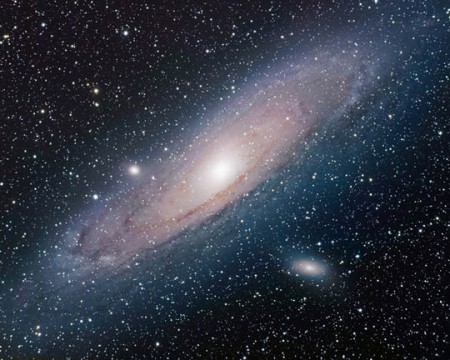
Frank Barrett / celestialwonders.com
Long before the "buy local" movement got underway we amateurs were galaxy shopping in the Local Group, a gravitationally-bound cluster of galaxies that includes three large spirals — the Milky Way, Andromeda Galaxy (M31), and Triangulum Galaxy (M33) — and some 50 dwarf galaxies spread across some 10 million light-years of space. The cluster's gravitational center lies between our galaxy and Andromeda, making its most distant member only about 4.5 million light-years away.
That's barely a stone's throw when you consider that we routinely hunt down galaxies 50 million light-years away and farther. So the Local Group must be a cakewalk, right? Not exactly.
Andromeda, its two bright companions, M33, and the Magellanic Clouds show details in binoculars and the smallest telescopes. A dozen more members might be seen in a 6-inch or (preferably) larger instrument, but the majority are too faint for amateur equipment. Just as there are far more ants than elephants, small, faint galaxies outnumber big, bright ones.
In the early winter sky, the Andromeda and Triangulum galaxies are often the focus of our attention because they're bright, well-placed, and loaded with detail. Andromeda's two brightest satellite galaxies, M32, a compact 8th-magnitude elliptical, and NGC 205, a dwarf elliptical, sit right next to the great Andromeda and "come along for the ride" every time we point a telescope in its direction.
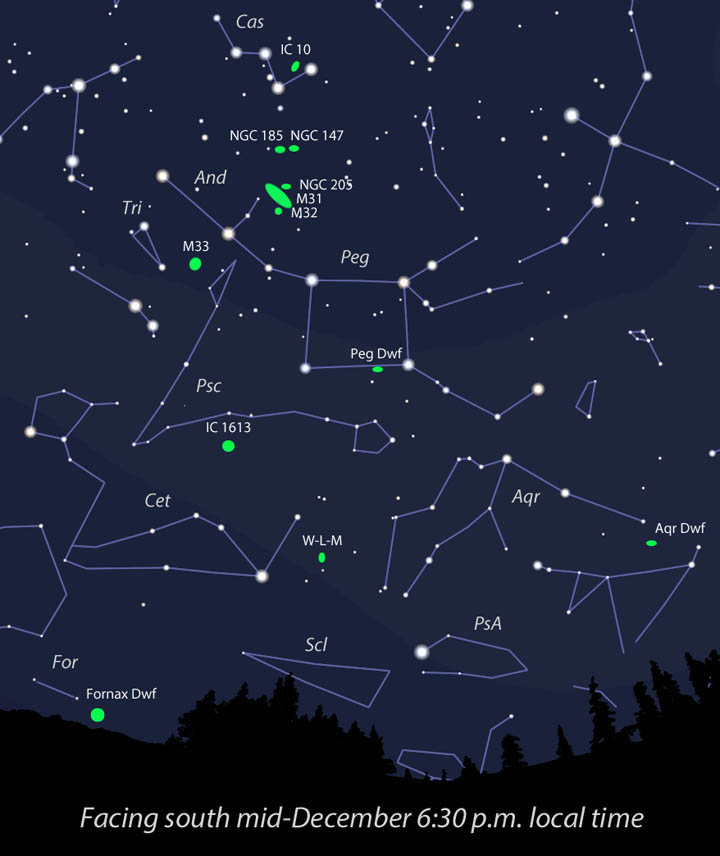
Stellarium / Bob King
M32 is a dense, slightly oval cloud bright enough to see in (big) binoculars. Through a telescope, it appears to protrude into Andromeda's southern edge, but in reality it's 110,000 light-years beyond the great spiral. NGC 205, also known as M110, lies an additional 50,000 light-years farther out. It's twice as large and clearly elongated but a magnitude fainter and more diffuse. The next time you visit the galactic trio, use your mind's eye to simulate space's third dimension: Picture the Milky Way foreground stars close to home in the foreground, M31 in the background, and its companions hovering just beyond.
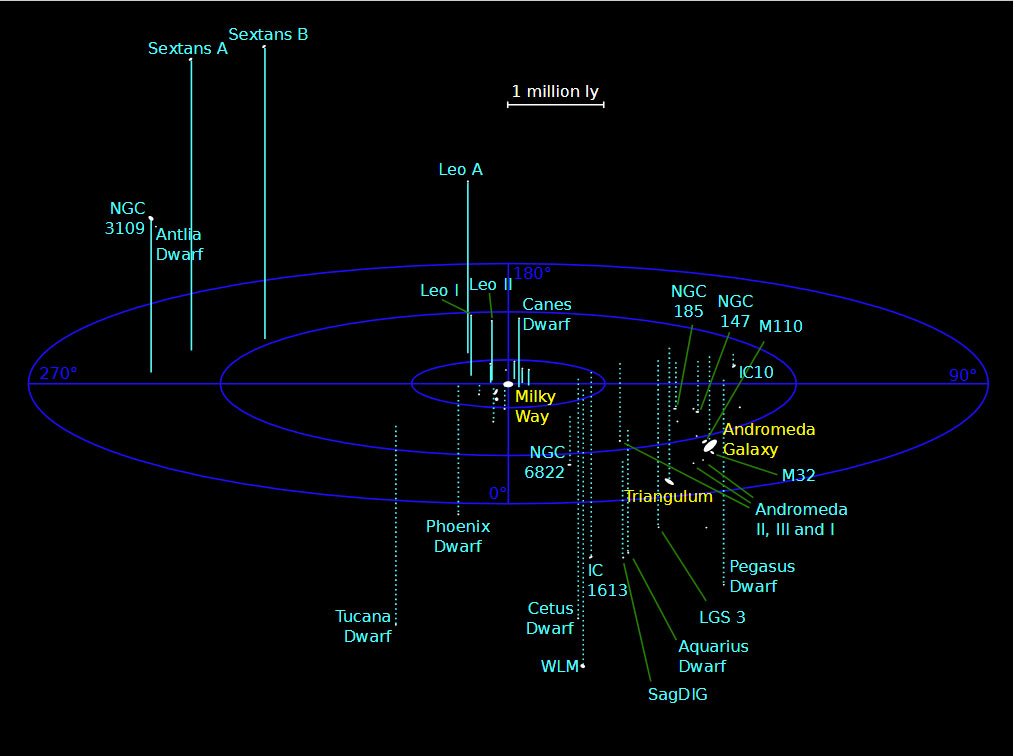
Richard Powell / CC BY-SA 2.5
Observers in the Southern Hemisphere have the pleasure of studying the Milky Way's two brightest satellite galaxies this season, the Large and Small Magellanic Clouds. Both are conveniently placed and visible to the naked eye from a dark sky; both offer a rich assortment of deep sky treasures for modest and large-aperture amateur telescopes.
The only other easy-to-spot Local Group members are Barnard's Galaxy (NGC 6822) in Sagittarius, currently lost in the solar glare, and two additional companions of Andromeda. Beyond these, we move into the realm of faint, smooth, and diffuse, words that described nearly every other local galaxy in the fall–early winter sky.
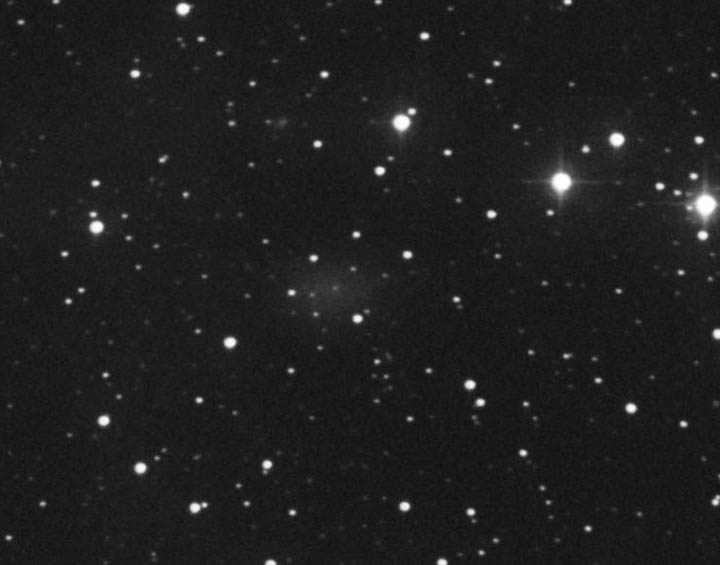
Martin Germano
Since Andromeda and friends have had their due elsewhere, we'll start with the Aquarius Dwarf (MCG –2-53-3), conveniently located 1.7° west of the globular cluster M72 in western Aquarius. It's a bit low in December, so you'll want to grab this one at the end of evening twilight or save it for next summer when it's better placed for viewing. In my 15-inch Dob, I saw a faint, oval patch of light with averted vision on several occasions using a magnification of 245× on a dark, steady night in late November. At magnitude 13.9, this dwarf irregular galaxy proved the most challenging of the bunch.
Because the bulk of the dwarf's star formation didn't get underway until 6–8 billion years ago, astronomers suspect it may never have interacted with our own galaxy. Small galaxies that pass near the larger and gravitationally dominant Milky Way often have their gases stripped away. Aquarius, 3.2 million light-years distant and relatively isolated, has escaped this fate.
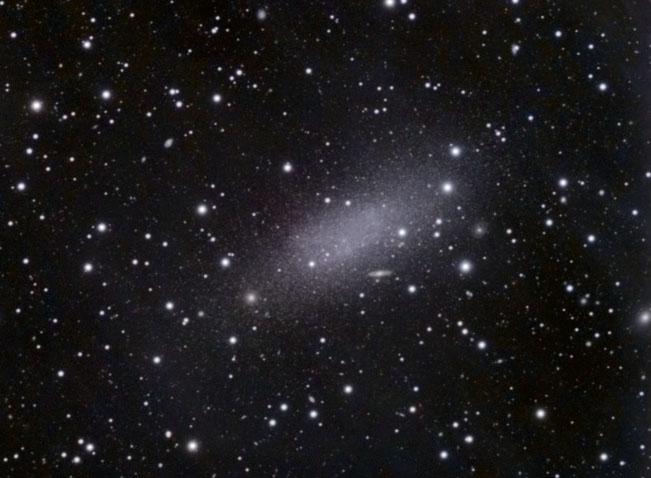
Alson Wong
Things get easier as we move east and north to the Pegasus Dwarf Galaxy (UGC 12613) located at the bottom of the Great Square. Discovered in the 1950s, it's another of the dwarf irregular galaxies even if it looks more like an edge-on spiral through the scope. Three million light-years distant and magnitude 12.6, it was plainly visible as a faint, smooth, east-west elongated oval glow about 4′ long at 142× and 245×. I detected no other details, not even a brighter nuclear region.
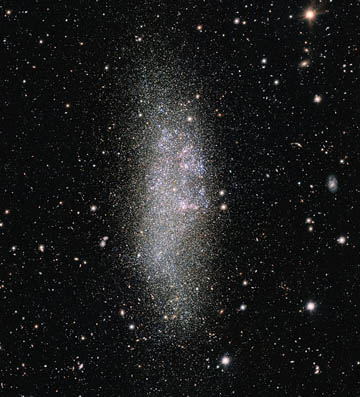
VST / Omegacam Local Group Survey
Next, we plunge south to Wolf-Lundmark-Melotte (WLM or MCG –3-1-15), an irregular galaxy discovered by Max Wolf in 1909 and situated at the fringe of the Local Group three million light-years away. The location's easy to find just 1° northeast of 6th-magnitude 1 Ceti, but seeing the galaxy took moving the scope around to coax it into view. WLM is faint and diffuse, requiring averted vision and magnifications of 100×–200×. After a few minutes, I picked up on the galaxy's north-south orientation and even noticed subtle variations in texture along its length.
While we're in Cetus, let's head north to the Pisces border and visit another dwarf irregular, IC 1613. This giant 16′ × 14.5′ puff of light is a featureless glow at 64× in the 15-inch. Once again, it was necessary to move the scope around to get a clear sense of its full, rounded shape and size. Few details were seen, but I did notice that the western side of the galaxy appeared a little brighter. This also happens to be where stars are most concentrated in a vaguely bar-like structure.
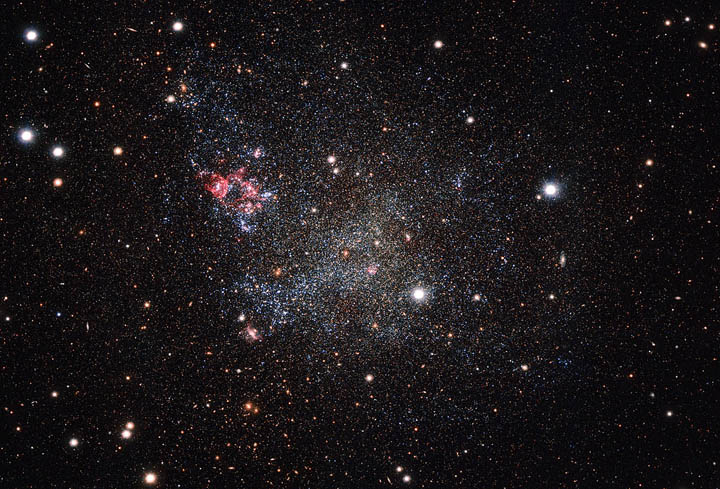
ESO
Other observers have used O III filters to faintly discern several rosettes of hydrogen emission created by supernova shock fronts and star-forming regions along the galaxy's northeastern side. This dwarf irregular lies 2.38 million light-years away, a bit closer than Andromeda. We know this with precision thanks to the dwarf's healthy population of Cepheid variable stars, which astronomers use as yardsticks to determine the distances to nearby galaxies.
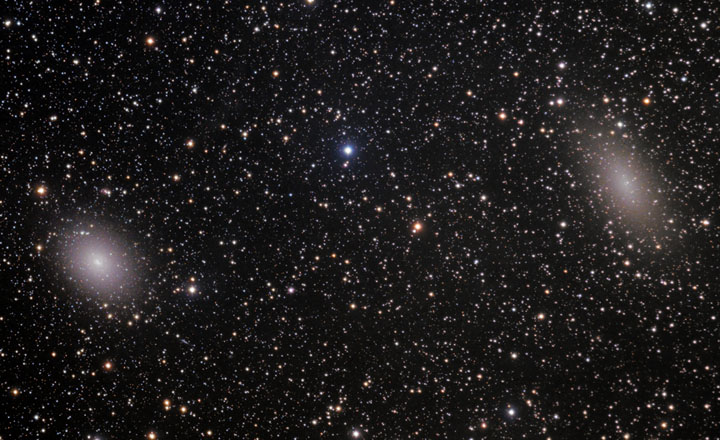
Hunter Wilson
From IC 1613 we head straight north to darker skies, passing showy M33 and M31 until we pull up alongside the fuzzy duo of NGC 185 and NGC 147, both easily found just 1° west of 4th-magnitude Sigma (σ) Cassiopeiae. Separated by just 1°, they're wide-ranging companions of M31 (7° to the south) and bright enough to see in a 6-inch from dark skies. NGC 185 appears distinctly smaller, brighter and more compact than its mate NGC 147, which looks faint and ghostly in comparison.
Both are smooth, elongated patches of light with brighter, non-stellar cores set in a rich field of foreground Milky Way stars. A few observers using 6- to 10-inch telescopes from dark skies have described NGC 185 as "granular" or on the verge of resolution. I couldn't believe this till I tried it myself. With averted vision and a magnification of 245× the galaxy appeared gritty from swarms of stars just below my resolution limit and resembled a barely-resolved globular. I'd love to hear if you can see this.
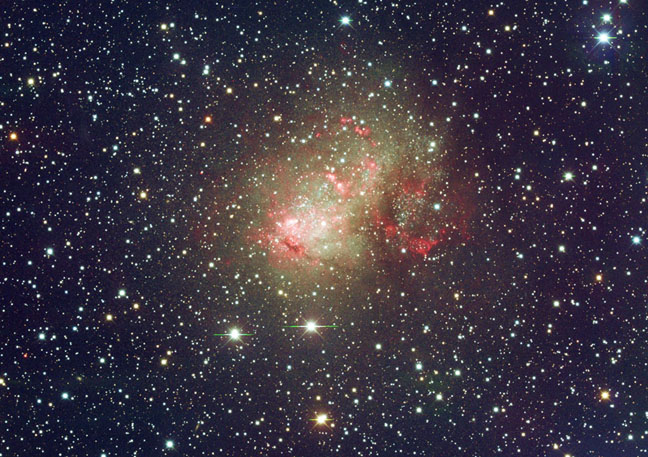
Lowell Observatory
Farther north in Cassiopeia we arrive at IC 10, a short hop 1.3° east of Beta (β) Cassiopeiae. I immediately detected an 11.8-magnitude milky glow at 64× in the 15-inch. Its southern end, where stars are more densely concentrated, is the brightest, most obvious part; to see the full 6′ length I had to use averted vision. IC 10 is the only starburst galaxy in the Local Group, where newborn stars are popping out all over the place.
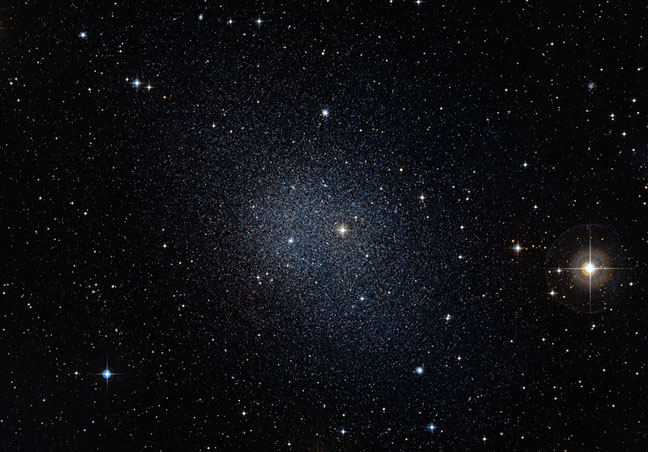
ESO / DSS2
For our final Local Group visit, we'll turn back south to the hinterlands of Fornax, the Furnace, down at declination –35°. From my home, the Fornax Dwarf Galaxy never gets higher than 8° above the southern horizon, one of the reasons I've never seen the galaxy itself. Too much thick air and haze! But on good nights using medium and high magnifications, I've succeeded in seeing four of the galaxy's six globular clusters. Those living much farther south may be able to spot the galaxy in a 6- or 8-inch wide-field instrument by sweeping back and forth over its position until a faint haze materializes.
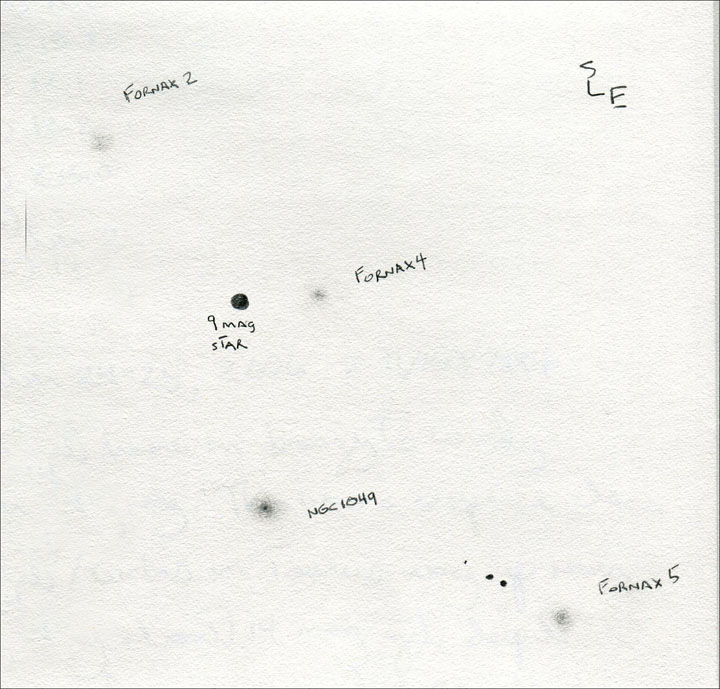
Bob King
The brightest globular, NGC 1049 at magnitude 12.9, is visible in an 8-inch, no problem. It even shows structure. In the 15-inch at 245× I can see a brighter core ringed by a fainter, diffuse halo. The other globulars — Fornax 2, 4, and 5 — appear as assorted faint puffs. I found the superimposed 9th-magnitude star very helpful for getting my bearings and navigating to the clusters. Fornax 1 and 6 are fainter than magnitude 15 and well beyond my latitude.
I hope you enjoyed our trip around the neighborhood. Some of the locals make easy acquaintance, others take effort, but I'm always inspired by these small fry. They and their ilk built the magnificent spirals and elliptical galaxies we spend most of our time ogling. We are grateful for their efforts and happy to call them our friends.
Need maps? We got 'em!
Select your target and click the link for a map. All have north up and show stars to magnitude 12 except for the Fornax chart (magnitude 8) and NGC 185, etc. chart (magnitude 9):
 10
10








Comments
SNH
December 21, 2017 at 5:06 pm
I've taken the time over the last few years to try and see as many of the Local Group galaxies as a I can in my 10-inch SCT. Of the twelve you listed and plotted, I've seen ten. That means I haven't seen the Fornax Dwarf or Aquarius Dwarf - though I should consider the trying the Aquarius Dwarf sometime. Of course I have seen four globular clusters in the Fornax Dwarf. Thanks for saying that M31 is actually 110,000 light-years beyond M31. Been doing some deep-sky object observing this autumn in M31 and also researching what I've seen. Really like the article. Hope it encourages others to push the limits of their telescopes a bit more under a dark sky. You will have to look at a few of the other M31 companion galaxies some time. I've heard that And II is visible in a 14-inch telescope and I've tried and failed once on it myself. Hoping that I might see the Ursa Major Dwarf (but probably no hope for the Draco Dwarf) in the future.
Happy Christmas,
Scott
You must be logged in to post a comment.
Bob KingPost Author
December 22, 2017 at 11:32 am
Hi Scott,
Thanks! I'm glad you mentioned the other Andromeda companions. I've tried and tried for And I and And II but have never convinced myself of seeing them. Foreground stars have been a problem with these not to mention how faint they are. I've also attempted the Draco Dwarf and only suspected a faint glow at the position. One day I hope to confirm that observation.
You must be logged in to post a comment.
Jamie-Dillon
December 22, 2017 at 8:42 pm
Fun write-up, Bob, thanks. I've made an ongoing project of collecting Local Group objects, have caught 17 in Felix my 11". You have to count Bruno's Galaxy, our home, mightily impressive in the summer sky. Want to say the Draco Dwarf was fun the one time I caught it, on a night in the Sierra foothills, limiting magnitude 6.2 for me, seeing 4/5. The fun part is it's so big, a degree long and half that wide. The trick was to scan back and forth, back and forth, to see the sky lighten and darken a bit. "A lucency across the field," is what I wrote in my notes. Fortunately I was seeing the right PA!
Leo I and the Sculptor Dwarf took spectacular nights, 6.5 LM and 5/5 seeing. I've never seen the Aquarius Dwarf, it's cruel. And forgive me, I figure you see M54, you've caught the brightest part of SagDEG. Otherwise SagDEG is pretty much a statistical object!
You must be logged in to post a comment.
Bob KingPost Author
December 22, 2017 at 10:17 pm
Thanks for writing, Jamie. You absolutely right about sweeping back and forth to see some of these. I think Leo I is much easier than the Draco Dwarf, but I've never even attempted the Sculptor Dwarf mostly because of its low altitude from my location. Hurray for M54 for pointing us to SagDIG, just as NGC 1049 takes us to the Fornax Dwarf.
You must be logged in to post a comment.
Bob
December 23, 2017 at 10:17 am
Great read. I am listening to Gustav Holst's The Planets at YouTube.
https://www.youtube.com/watch?v=Isic2Z2e2xs
Good way to spend Saturday morning -- reading my favorite S&T blog -- listening to some of my favorite classical music.
Bob
Kentucky
You must be logged in to post a comment.
Bob KingPost Author
December 24, 2017 at 12:51 am
Hi Bob,
That's a nice thing to say and good music to listen to. Do you have a favorite planet in the composition? Mine is Jupiter closely followed by Saturn. Jupiter is so easy to like with its great melody and spirit.
You must be logged in to post a comment.
Fabrice Morat
December 23, 2017 at 3:37 pm
Hello Bob,
A great story as you usually do... When i was waiting for the big Dobson several years ago, i've tried some objects of the Local Group with the only instrument i had got : binoculars Miyauchi 45x141.
It had been a good surprise some very faint objects could be sketched with some details at times. Finally, many faint objects of the Local Group which present a large apparent size like dwarfs are ideal for big binoculars or RFT : they have an impressive surface brightness (irrealistic for some amateurs) like > mag 15.sec-². This fact produces a curious observational effect : some amateurs can't detect them with big Dobsons probably because of inadequacy of amplification. Here is my personal list (with drawings) observed with the Miyauchi at 45x or 25x : NGC 6822, WLM galaxy, IC 1613, Sextans A, Sextans B, Leo I (with a C11), Leo II, Ursa Minor dwarf, Draco dwarf.
Nota : certain galaxy Holmberg display the same difficulty.
We need several years to observe all these close objects. Your full article is the best way to attempt again...
Fabrice M. (from La Palma island)
You must be logged in to post a comment.
Bob KingPost Author
December 24, 2017 at 12:56 am
Dear Fabrice,
Oh, how I wish I had a pair of binoculars like yours. You make an excellent point about needing a large field of view to see faint, distended objects. With the 1° field of my 37-cm scope, I have to sweep back and forth to "simulate" a larger field in order to see some of these faint puffs. Your achievement is impressive. I've suspected the Draco Dwarf and plan to try for Sextans A and Sextans B in the spring.
You must be logged in to post a comment.
Jamie-Dillon
December 24, 2017 at 5:56 am
Brian Skiff at the Lowell keeps a chart of the confirmed Local Group members at ftp://ftp.lowell.edu/pub/bas/deepsky/local.group Reminds me of why I never thought about Sextans A and B. They're part of the ngc 3109 group. Do look possible from the numbers, though.
Hartmut Frommert, Spider himself, has a cool Local Group site with links to his SEDS pages, with history, links and photos - http://spider.seds.org/spider/LG/lg.html
His photo for And 1 will give you the idea, it doesn't show in the detail photo. And 2 doesn't even get a photo.
About latitude, I live in Salinas, CA, on the central coast; that view I got of the Sculptor Dwarf was from Lake San Antonio, not far south of here, at 35.8N.
All this said, please let me aver that I am going to Chile to see the Magellanic Clouds. It's high time.
You must be logged in to post a comment.
Fabrice Morat
December 24, 2017 at 3:45 pm
This night (second part), i was in Hydra and remembered your illustration showing the repartition of the local group. When i saw NGC 3109 in the atlas, i nervously looked at this beautiful galaxy, the vision with the 24" was quite easy (nothing to see with the discrete dwarfs...). The only problem was my tiredness to make a detailed sketch of it. I've made a little mistake just above, surface brightness of 15 or greater are of course in mag.arcmin-² and not in arcsec.
Happy deep sky at all,
Fabrice M.
You must be logged in to post a comment.
You must be logged in to post a comment.